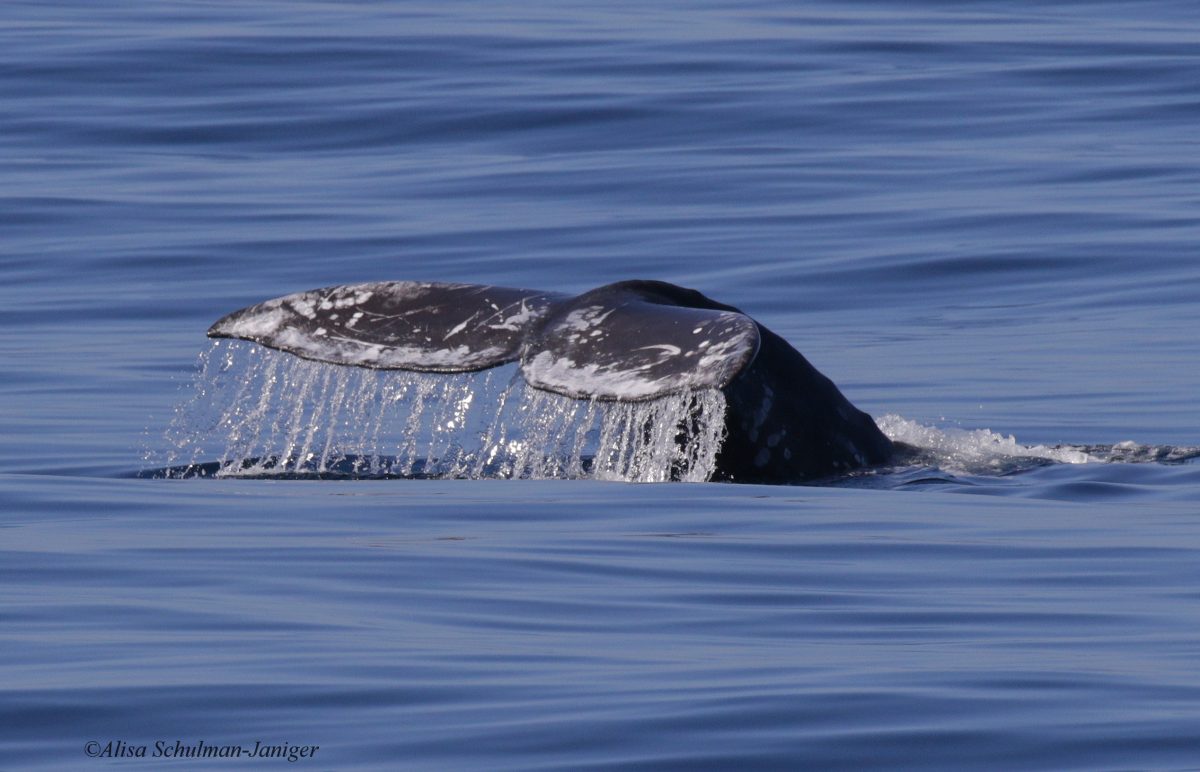Citizen scientists at the Point Vicente Interpretive Center are documenting a historic low in Gray Whale sightings, but the apparent decline doesn’t tell the whole story
by Chelsea Sektnan
From sunrise to sundown, binoculars pressed to their eyes, volunteer whale counters at the Point Vicente Interpretive Center in Rancho Palos Verdes scan the Pacific for the telltale puff of a gray whale blow. Some days, the ocean yields nothing but waves. Other times, a ripple, a spout, or the curve of a back is enough to send a thrill through the watchers on the bluff.
Every day from December 1 through May 25 — the months of the gray whale migration — citizen scientists with the American Cetacean Society-Los Angeles Chapter (ACS-LA) Gray Whale Census and Behavior Project are stationed on the bluffs from about 6 a.m. to 6 p.m., watching the water and recording every sighting. Projects like this are part of a growing citizen science movement, where everyday people contribute to ecological research alongside marine biologists.

“We’ve already had 31 days this season where no gray whales were spotted at all — and that’s not even counting April or May,” said Alisa Schulman-Janiger, marine biologist and director of the Gray Whale Census Project. “That’s highly unusual for this time of year.”
As of April 11, just 121 southbound gray whales and 404 northbound had been recorded — a dramatic drop from 2024’s already record-low totals on April 11 of 224 southbound and 528 northbound, including 19 calves.
The dip in local sightings is part of a troubling trend seen all along the Pacific Coast. In Mexico’s Baja lagoons, where gray whales typically give birth and nurse their young, observers have reported a high number of deaths this season. Schulman-Janiger noted that friends recently sent her photos of gray whales in the Sea of Cortez — further south than usual.
“There’s way fewer calves seen in the lagoons,” she said. “The gray whales tend to go further south during La Niña when the water is colder, reports are of large numbers earlier in the season off Cabo.”
Diane Alps, a local researcher and programs director at Cabrillo Marine Aquarium, has been monitoring the season closely.
“It’s definitely a lean year,” Alps said. “But whale migration isn’t a straight line. There are so many factors — food availability, ocean temperatures, offshore currents — and the whales respond to all of it. They go where the conditions are better.”
She’s quick to point out that a quiet season doesn’t mean whales aren’t out there.
“They’ve been through ice ages. They’ve been through industrial whaling. Gray whales have survived a lot,” said Alps. “Just because we don’t see them from shore for a season or two doesn’t mean they’re gone.”
On April 3, a glimmer of hope surfaced. Two cow-calf pairs were finally spotted.
“It’s the only two we’ve had the entire year, so it’s good there’s at least a couple,” said Joanne Kajiyama of Los Angeles, a longtime whale count volunteer. “But it’s very depressing that there’s only two. We’ve never had a year with just two at this point. Still, it’s always hopeful when you see any of them.”
“I’m a little bit hopeful,” added Gail Goulet of Hermosa Beach, a citizen scientist and whale count volunteer, now in her third year. “It’s so low. It is a bit depressing. But it’s still amazing to me when I see one.”
The current population decline traces back to January 2019, when NOAA Fisheries declared an Unusual Mortality Event (UME). The main cause? Lack of food — the result of climate-driven changes in the whales’ Arctic feeding grounds.
“Basically caused by lack of food, basically due to climate change, which means warmer water in their feeding grounds, which killed off their primary source of prey,” said Schulman-Janiger.
The UME was officially declared over in late 2023, but the gray whale population remains severely depleted.
“Although the number of dead whales fell into [the normal] range, it’s a higher percentage because you have fewer whales,” Schulman-Janiger said. “So there was a little uptick in the number of calves seen, and there was a drop in the number of dead whales seen. So that’s why the UME was declared over. But we’ve got fewer whales, fewer calves — way fewer calves — and a lot of skinny whales.”
Still, Alps believes there’s resilience in the species, and in the people watching them.
On April 4, Stacey Hiram of Redondo Beach, a citizen scientist and whale count volunteer, spotted one of the few gray whales seen that day.
“This is my office,” said Hiram, who volunteers two to three times a week. “It’s exhilarating — it gets you excited, but it calms you inside. You’re out here with nature.”
Theresa Stahlman-West, in her third season and a weekly volunteer from Los Angeles, finds joy in the learning process as much as the sightings.
“Even if we don’t see whales, it’s just a wonderful place to be,” she said. “I was a biology major, and this kind of brought me back to that. I’m always learning something.”
The weather has complicated the count. Fog, wind, and rain have repeatedly limited visibility and forced the citizen scientists to leave early or not count at all.
“There was a day last week that they never saw the water,” Schulman-Janiger said. “And when there’s whitecaps everywhere, like we had a blow today — we saw there was a gray whale — but we never could see it again.”
Even on clear days, some whales may be migrating out of sight.
“There’s no way to know if they’re traveling far offshore because we’re not watching offshore,” she said.
Captain Dan Salas, founder of Harbor Breeze Cruises in San Pedro, said he’s seeing whales adjust.
“We’re in a down cycle right now. It’s like fishing or kelp — ocean life goes through natural ups and downs,” Salas said. “These animals are smart. They’re adapting. We’re seeing more humpbacks than we have in a long time, more fin whales, and blue whales – lots of them. The ocean is shifting, and the whales are adjusting. And the gray whales? They’re figuring it out.”
“They don’t have calendars. Their migration is tied to ice and instinct. If the ice melts early, it throws off their timing. But you know what? They adapt — they always have,” he said.
Sara Lesser, Whale Watch Naturalist Program Coordinator with the Aquarium of the Pacific in Long Beach, echoed that message.
“Gray whales are known to explore,” said Lesser. “We saw fewer whales coming south, but a lot more going north, which suggests they may have taken a different route. Just because we aren’t seeing them from shore doesn’t mean they aren’t coming. They’re behaving differently this year, and that’s something we need to pay attention to.”
She noted that the population estimate rose from NOAA’s estimated population count of 14,000 to 19,000 last year, offering some cause for optimism. Some whales have also been found dead along the northern California coast, including inside San Francisco Bay, and more recently on Huntington Beach — a phenomenon that raises concern, but isn’t entirely new.
“The numbers can sound scary, and there is a potential, but there’s a lot we don’t know,” Lesser said.
She encouraged public engagement.
“Just learning about these animals, their migration, their challenges, that in itself is an act of conservation,” she said. “Getting out on the water and seeing them in their natural habitat is one of the best ways to connect with and protect them.”
For Salas, that connection is unforgettable. As the captain of Harbor Breeze Cruises, a whale watching company based in San Pedro, he’s spent decades taking people out to see marine life up close — often for the first time.
“Some of these kids come from Inglewood or East L.A. and have never even seen the ocean,” he said. “They come out with us on field trips, and when they see dolphins or whales for the first time, some of them cry. Their whole face lights up. It’s magic. That’s why it’s so important to get people out on the water. When you see a whale up close, it’s not just a cool moment. It sparks something. It creates a lifelong respect for the ocean.”
Robert Sokolich, who rides his motorcycle from Torrance once a week, said even a brief sighting is rewarding.
“Most of the time you just see a blow, but if you see a back or a fluke, that is a prize,” he said.
Even in the quietest moments, researchers and volunteers stay committed.
“I’ve been coming here for 28 years,” said Mike Malone, a citizen scientist and Rancho Palos Verdes resident. “It’s peaceful, it’s meaningful — and even after all this time, every whale sighting still feels special.”
Each sighting contributes to a growing body of data that helps researchers and conservationists better understand whale migration, behavior, and overall population health.
“The whales remind us that nature is still out there — adapting, surviving, surprising us,” said Salas. “Every season brings something new. And every time we spot one, it’s like seeing a miracle all over again.”
Want to Get Involved? Here’s How
- Join the Gray Whale Census
The ACS-LA Gray Whale Census and Behavior Project welcomes new volunteers each fall. The season runs daily from Dec. 1 to May 25 at Point Vicente in Rancho Palos Verdes. Training is provided — all you need is enthusiasm and a good pair of binoculars. Learn more at acs-la.org. - Go on a Whale Watch
Companies like Harbor Breeze Cruises in San Pedro and and Redondo Whale Watch in King Harbor offer year-round whale watching trips, often in partnership with naturalists from the Aquarium of the Pacific. Seeing whales up close is not only awe-inspiring — it supports ocean education and conservation. - Learn and Share
You don’t have to be on a boat to help whales. Follow trusted organizations like NOAA, Cabrillo Marine Aquarium, or the American Cetacean Society to stay informed. Sharing science and sightings with others builds public awareness and advocacy. - Protect Their Habitat
Reducing single-use plastics, supporting clean oceans, and advocating for marine protections are powerful ways to support whales — from wherever you are.











